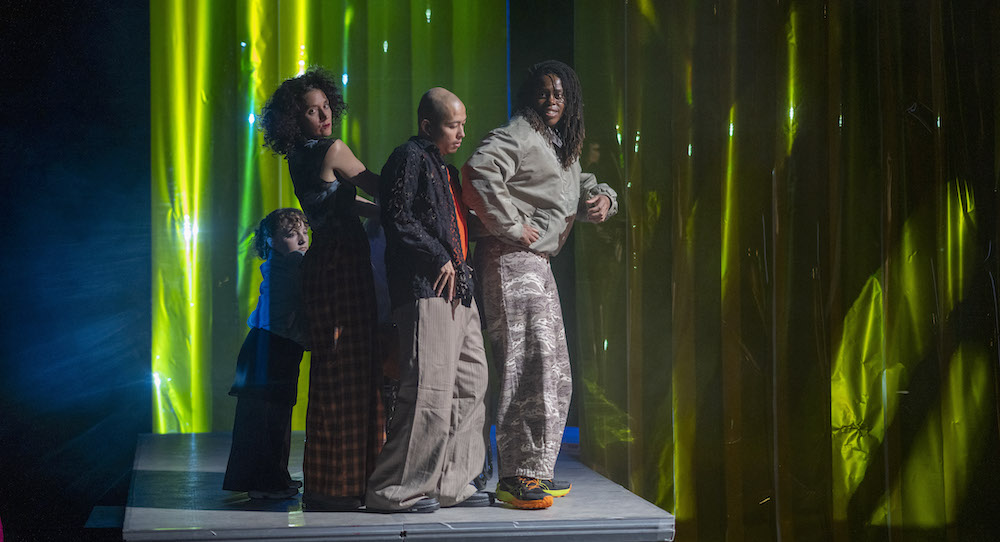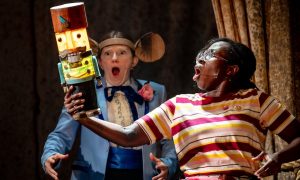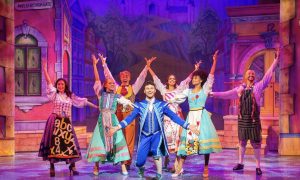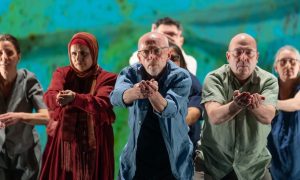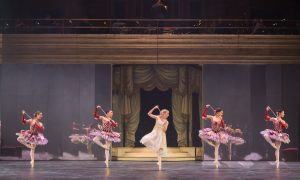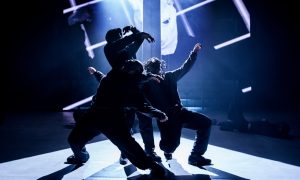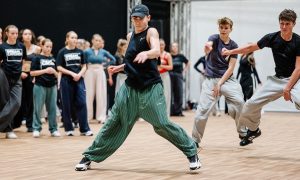Sadler’s Wells East, London.
2 July 2025.
Over and Over (and over again) by Candoco Dance Company and Dan Daw Creative Projects finds a perfect setting at the newly opened Sadler’s Wells East. The large, industrial-feel theatre provides the ideal environment for this nightclub rave-inspired piece, with the shows curated relaxed space and accessible ethos allowing audience members to move, rave in their seats, or leave when they want.
You can almost still smell the freshness and feel the raw materials at Sadler’s Wells East, with the vast venue officially opening just months ago at the start of 2025. Audience members who have danced the night away in a club or at a warehouse rave will feel oddly at home watching this piece, voyeuristically, as if they were a fly on the wall, watching a group of friends escape to a dark club for a good time.
The narrative is simple: a group of friends on a night out, with the story unfolding through dance, set to metronomic beats and the occasional word projected across a PVC stripe curtain, reflecting the energetic state, internal monologue, and dynamics of the friendship group.
A 60-minute beat-driven piece that perfectly honours Candoco’s vision and legacy, producing high-quality work featuring both disabled and non-disabled dancers, with the ensemble comprising Anna Seymour, Annie Edwards, James Olivo, Maiya Leeke, and Temitope Ajose.
Each dancer brings a unique dynamic to the piece, with choreography that features group moments where, at times, the dancers move in a symbiotic fashion, always connected through touch, careful not to break their link even when floorwork is incorporated. To breakout duets, such as Seymour and Ajose, which show lust and how romance and passion can form in the dark corners of a club, to trios and solos.
A simple yet effective set, design concept and costume design concept by Erin Guan, features exposed lighting rigs with a series of solid beams, accompanied by flashing lights designed by Nao Nagai, which are used throughout to indicate the passage of time and to signal the dancers’ states. The lighting also provided a moment of humour with the ‘end of night’ lights coming up at the shows climax to symbolise that the rave was over and although the club-goers didn’t have to go home, they couldn’t stay there; a feeling the seemed to resonate with the audience as they let out a collective sigh and laughter.
Although vast in size, the stage gives the appearance of a neutral black box theatre, often reserved for smaller spaces above pubs and independent theatres. Exposed, open and deep black, there is a small, raised stage featuring a ramp with the PVC curtain caressing it, sat centre stage. Not a single inch of the stage is not explored by the dynamic and at times frantic choreography. The raised platform is used to highlight moments or to draw the audience into junctures of rest and embrace.
The PVC curtain also serves as the backdrop for a retro-style film projection screen, think of a home movie filmed in the 90s. Footage was taken live on stage via dancer Olivo, with the PVC curtain reminiscent of a secret door or, dare we say, an underground club hidden behind warehouse doors and a frosted curtain to conceal what lurks inside, and hugging your skin as you enter.
A standout moment that comes early in the show and that perfectly combines dance, costume, lighting, and set is when dancer Leeke becomes a human disco ball, with the lights reflecting off her mosaic-style mirrored top, casting light across the front rows of the auditorium, which was met with elation. Another notable choreographic moment comes in Olivo’s closing solo. Set at the end of the night, when exhaustion and alcohol shift one’s presence to almost an out-of-body state, a series of twisted, tormented, and musical movements showcases the struggle of a long evening, with fragments revealing the toll of a greater battle and a cathartic release.
Words such as ‘Break’, ‘Solidarity’, and ‘Chill-out’ splash across the PVC curtain throughout the performance, serving as snapshots of the dancers’ and clubbers’ psyches at that point in the night. The choreography perfectly uses light and shade to help increase and decrease tempo. When paired with the projected key words, glimpses into the friends’ night out could act as a memory trigger for the audience, reflecting their evenings out, or ‘out out’ as we say in the UK.
The show doesn’t quite inspire the audience to join in and let themselves go on the dance floor, but instead evokes a reflective desire to reminisce about late nights with friends, dancing until the club lights come up, and pardon the cliché, dancing like no one is watching.
At times, movements can seem monotonous, but they work by matching the repetitiveness of a club soundtrack. What sprang to mind during the performance was the saying ‘Eat, Sleep, Rave, Repeat’.
Sign language and dance blend seamlessly, emphasising that dance is a universal language. The choreography, through motif development and stage exploration, showcases the highs and excitement of a night out, as well as the struggles of trying to maintain your energy to make it through the evening, and the challenges of struggling to function.
By Jamie Body of Dance Informa.


